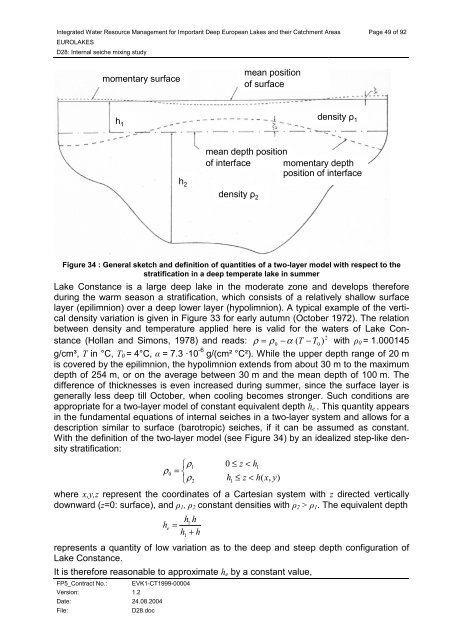D28: Internal seiche mixing study - Hydromod
D28: Internal seiche mixing study - Hydromod
D28: Internal seiche mixing study - Hydromod
Create successful ePaper yourself
Turn your PDF publications into a flip-book with our unique Google optimized e-Paper software.
Integrated Water Resource Management for Important Deep European Lakes and their Catchment Areas<br />
EUROLAKES<br />
<strong>D28</strong>: <strong>Internal</strong> <strong>seiche</strong> <strong>mixing</strong> <strong>study</strong><br />
momentary surface<br />
h 1<br />
h 2<br />
FP5_Contract No.: EVK1-CT1999-00004<br />
Version: 1.2<br />
Date: 24.08.2004<br />
File: <strong>D28</strong>.doc<br />
mean position<br />
of surface<br />
mean depth position<br />
of interface momentary depth<br />
position of interface<br />
density ρ 2<br />
density ρ 1<br />
Page 49 of 92<br />
Figure 34 : General sketch and definition of quantities of a two-layer model with respect to the<br />
stratification in a deep temperate lake in summer<br />
Lake Constance is a large deep lake in the moderate zone and develops therefore<br />
during the warm season a stratification, which consists of a relatively shallow surface<br />
layer (epilimnion) over a deep lower layer (hypolimnion). A typical example of the vertical<br />
density variation is given in Figure 33 for early autumn (October 1972). The relation<br />
between density and temperature applied here is valid for the waters of Lake Con-<br />
2<br />
stance (Hollan and Simons, 1978) and reads: ρ = ρ0<br />
−α<br />
( T − T0<br />
) with ρ0 = 1.000145<br />
g/cm³, T in °C, T0 = 4°C, α = 7.3 ·10 -6 g/(cm² °C²). While the upper depth range of 20 m<br />
is covered by the epilimnion, the hypolimnion extends from about 30 m to the maximum<br />
depth of 254 m, or on the average between 30 m and the mean depth of 100 m. The<br />
difference of thicknesses is even increased during summer, since the surface layer is<br />
generally less deep till October, when cooling becomes stronger. Such conditions are<br />
appropriate for a two-layer model of constant equivalent depth he . This quantity appears<br />
in the fundamental equations of internal <strong>seiche</strong>s in a two-layer system and allows for a<br />
description similar to surface (barotropic) <strong>seiche</strong>s, if it can be assumed as constant.<br />
With the definition of the two-layer model (see Figure 34) by an idealized step-like density<br />
stratification:<br />
�ρ1<br />
0 ≤ z < h1<br />
ρ0<br />
= �<br />
�ρ2<br />
h1<br />
≤ z < h(<br />
x,<br />
y)<br />
where x,y,z represent the coordinates of a Cartesian system with z directed vertically<br />
downward (z=0: surface), and ρ1, ρ2 constant densities with ρ2 > ρ1. The equivalent depth<br />
h e<br />
h1<br />
h<br />
=<br />
h + h<br />
1<br />
represents a quantity of low variation as to the deep and steep depth configuration of<br />
Lake Constance.<br />
It is therefore reasonable to approximate he by a constant value,









